Increasing Quality in large scale University Courses
E-flashcards as an approach to support active learning and individual facilitation
urn:nbn:de:0009-5-36551
Abstract
Quality of education should be stable or permanently increased – even if the number of students rises. Quality of education is often related to possibilities for active learning and individual facilitation. This paper deals with the question how high-quality learning within oversized courses could be enabled and it presents the approach of e-flashcards that enables active learning and individual facilitation within large scale university courses.
Keywords: e-learning; education; quality management; university course; flash card
A rising number of students is one of the main challenges for universities. In Germany for example the number of first-year students increased between 2001 and 2012 by about 50 % [Fed12]. The reasons are manifold: the elimination of military service, two groups of people with university-entry diploma due to reduction of school time and a generally increasing education level are mentioned. Experts of the responsible ministry in Germany do not expect a decreasing number of students before 2025 [Fed12]. In contrast to the increasing number of students, a high quality of education is still required. In this context, the German government initiated a funding program called “qualitypact education” in order to optimize terms for students´ education.
Different approaches are possible to keep or increase the quality of education. They integrate different, evaluated approaches and are adapted to concrete constraints. From our point of view, the following guidelines should be considered:
-
Quality of education means user adequate and comprehensible as well as correct content
-
Quality of education means possibilities of active learning
-
Quality of education means individual feedback
When developing a new approach of education in large scale courses, tutors have also be taken into account because large scale courses are also a special challenge. Topics of interest are possibilities for reusing (user-generated) content in follow-up courses. Reuse avoids effort in developing learning content and gives time for the direct contact und facilitation for the students.
This paper proposes e-flashcards as an integrated approach to improve the quality of education in large scale courses. This approach especially addresses the facilitation of the students and implements the above mentioned guidelines. Chapter 2 presents related work, before chapter 3 shows the concept and chapter 4 the implementation of e-flashcards. The paper ends with a short view on first evaluation results, a conclusion and an outlook (chapter 5).
The approach of e-flashcards is mainly related to work on active learning and feedback. Regarding the topic of active learning, such approaches are widely accepted that are based on constructivism and emphasize that active learning deals with own production and discussion of (learning) content [Ko96]. The huge community of Computer-Supported Collaborative Learning (CSCL) is based on these assumptions and shows the positive effect of active learning on the learning success (see for example [SH12]).
The CSCL community also showed that learning content is more comprehensible when it is developed by the students themselves. This is grounded in the theory of socio-technical systems [Mu06] that emphasizes that the user generated content is based on the pre-knowledge of the students [EHM07]. For large groups, IT-platforms for the (cooperative) development of online-modules, wikis and lists of questions for a given learning object are proposed [CK08].
Individual facilitation is given for example by feedback of a tutor to student-generated content. Feedback in existing studies is often related more to the quantity than to the quality of students´ contributions [Ch03]. With respect to qualitative feedback future studies are required that show the effect of qualitative feedback by students and tutors on the learning success.
The study of related work shows that active work on and development of learning content as well as individual feedback are promising didactical possibilities. In our own work, these approaches will be integrated and adapted to the scenario of large scale course.
The preference for an active work on online learning content was also shown in a survey that was conducted amongst students (N = 102) of three computer science courses at the Dortmund University of Applied Sciences and Arts in November 2011. Students rated the requirements for more exercises and test questions in addition to practical courses as high (59% students for test questions) resp. very high (67 % of students for exercises).
The approach presented here picks up the idea of developing small learning snippets in form of electronical (e-)flashcards. These e-flashcards are developed by students and should be suitable to control the understanding of the learning content (see e.g. [BM93, CC08]). The small snippets are „Microunits“ in the sense of Microlearning (see [Hu05]).
To support active work on the learning content, the e-flashcards are integrated in an overall process of developing and rating e-flashcards in relation to the corresponding courses. Figure 1 gives an overview of the principle process that was developed and evaluated at the Dortmund University of Applied Sciences and Arts.

Figure 1: The concept of mobile e-flashcards
Learners develop e-flashcards that consist of a question and related answers. The e-flashcards are provided to other learners and/or tutors.
Other students can receive these e-flashcards and thereby deepen their understanding of the learning content and check their success of learning. The concept of Microlearning enables a fast and direct feedback about the success. Additionally, students have the possibility to rate the e-flashcards in order to actively work with the cards created by other users. In this way, active learning – mainly of facts – in large scale groups becomes possible.
The individual facilitation of the authors occurs through (qualitative) feedback of the tutors for the e-flashcards. The student can revise his/her e-flashcard if necessary. The developed and revised e-flashcards are reviewed in a concluding step (“quality filter”). Checked and positively rated content can be reused as a question pool in follow-up courses.
The approach also includes the idea of a mobile access to the e-flashcards. This addresses the „common” technical equipment and usage of media of the younger people [Ca05]. Learning also becomes possible anytime and anywhere.
All in all, the presented approach integrated the success models of active learning presented in chapter 2 and combines it with individual feedback and the reuse of learning materials.
This chapter describes the implementation of the e-flashcards concept. It starts with an outline of the creation and use of e-flashcards and continues with mechanisms of quality control and individual feedback. Moreover, the underlying software architecture and the pilot phase will be presented.
Learners can create e-flashcards for a lesson of a course using a web-based client. Each e-flashcard consists of a question and the related answer page.
As an example, Figure 2 shows the two sides of an e-flashcard. A creator of an e-flashcard can decide to publish it to all other users in the flashcard pool or to use to in a private mode. The creator of a shared e-flashcard can still edit it, but cannot delete it, because it might be used by other learners. Tutors and lecturers can edit and disable e-flashcards in the flashcard pool.
The operating concept to learn with e-flashcards is based on the use of paper-based flashcards study sets. First, the learner reads the question page and afterwards the related answer to the question of the e-learning flashcard. Then, the learner decides whether he or she has answered the question correct. This approach enhances the self-reflection of the learners, because they have to check their own answers for accuracy. A correct marked e-flashcard is sorted into a compartment which is less frequently repeated, otherwise it is placed in a compartment that is repeated frequently.
A learning history stores the self-reflection of the learner on the different e-flashcards. The repetition rate of e-flashcards in a learning session is calculated based on the learning history. At the beginning of each learning session, the user can choose the e-flashcard presentation mode, for example the presentation of e-flashcards in a fixed or random order out of one compartment, of different compartments according to the learning-history, or randomly in an assessment mode (see Figure 2).
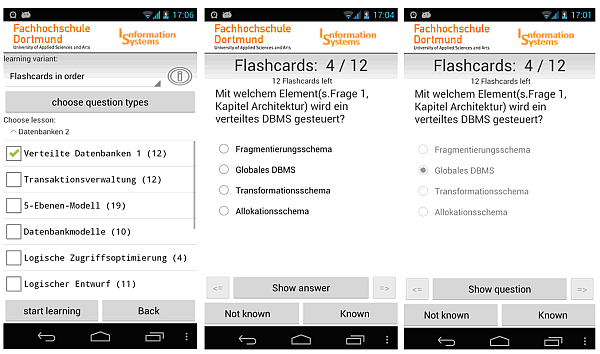
Figure 2: Screenshots of the mobile e-flashcard application ( video )
As part of the quality control, the comprehensibility and accuracy of the user-generated e-flashcards has to be ensured. To achieve this, each learner can write a review for each shared e-flashcard. Each review consists of a rating between 0 and 5 point in the categories: "content", "difficulty" and "comprehensibility". Moreover, a free-text review of the e-flashcard is possible (see Figure 3). Thus, several reviews may exist for an e-flashcard.
The user can choose how many and which reviews are replicated to the mobile device. Due to the observation, that these reviews may depend on the level of knowledge of the reviewer, the user's role is stored together with the review. Therefore, the ratings of learners, teachers and tutors can be distinguished. Depending on the rating and the reviewer’s role, the learner can choose the subscribed e-flashcards for a lesson of the course (see Figure 3).
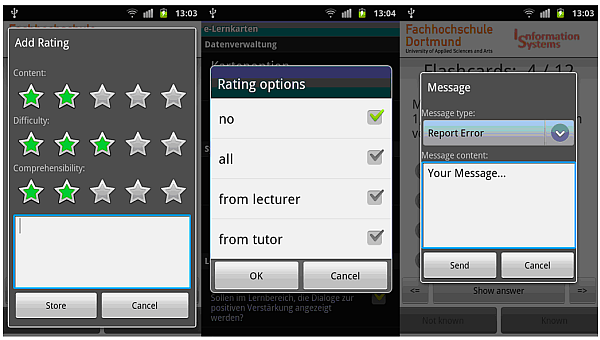
Figure 3: Review and message functionality of the mobile e-flashcard application ( video )
If issues depending on an e-flashcard have emerged, the learner can send a message to the supervising tutors using a context menu of the mobile question and answer page. This message contains information about the e-flashcard, a header, such as "Report an Error" or "question", as an additional free text (see Figure 3).
Due to tutor feedback, the learners receive direct individualized feedback. Simultaneously, tutors can quickly react to questions about or errors in an e-flashcard through this communication channel. Tutors can comment, correct immediately, ask the e-flashcard creator for correction or disable erroneous, duplicate or misleading e-flashcards. Learners who have subscribed a changed e-flashcard are informed via the synchronization process with the server-side database. At the end of a course, the created shared e-flashcards are reviewed by the tutors. High-quality e-learning cards will remain for re-use in flashcards pool, while others will be removed by tutors (see Figure 1).
Figure 4 shows the rough architecture of the e-flashcard system, which was created as a separate system in addition to the learning management system ILIAS [IL13] used at our university. This was necessary, because ILIAS right now lacks some possibilities to store and provide e-flashcards for a mobile application.

Figure 4: Architecture overview
Two applications were implemented to access to the e-flashcard-pool: a web server application and a mobile application. The web server application supports the use and creation of e-flashcards. To enable a user-friendly, offline mobile learning with the e-flashcards, a native Android application was developed [An12]. The learner subscribes lessons to determine the e-flashcards to be used on the mobile device. These subscribed e-flashcards are replicated in in a SQLite database [Sq12] on the mobile device.
Figure 5 shows an extract of the ER model of the server-side database which is replicated on the mobile device. It contains the entities "user", "flashcard", "course" and "lesson" as well as the relations for modeling the management, use and reviews of e-flashcards. The server-side database model contains additional entities to model the flashcard and learning history and the user role. Due to the synchronization of the used learning objects, the learner can use simultaneous both applications.
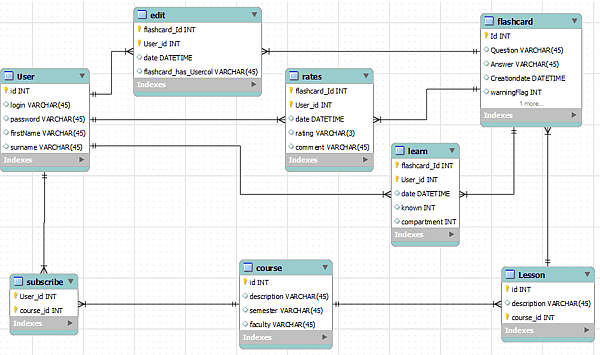
Figure 5: Part of the ER-Modell of the database schema
The pilot phase took place in the summer term 2012 accompanying a database lecture. To get an initial stock of e-flashcards, parts of online learning modules created in previous courses by students were converted to e-flashcards. In this first approach, text-based multiple choice questions and fill in the blanks questions of the online learning modules were used. Figure 6 shows the original test question of one of the used online learning module corresponding to the e-flashcard of Figure 2. Each question of the online-learning module was converted into an e-flashcard and assigned to the corresponding lessons in the e-flashcard pool. The IMS Question and Test Interoperability Specification [IMS13] was used as an interchange format between the online learning module and the e-flashcard pool.

Figure 6: Example of a question of an online learning module (user-generated content)
The pedagogical scenario to exemplify the use of e-flashcards within this course consists of four phases:
-
In the first phase of the course, one course member is assigned to one lesson and creates a predetermined number of e-flashcards for that course lesson.
-
In the second phase, the course members review the created e-flashcards of the other course members. In this case, an assignment of students to each lesson is appropriate to cover all created e-flashcards.
-
A correction phase follows, in which the course members go over the self-generated e-flashcards according to the feedback of the other course members and the tutors.
-
In the test preparation phase, each course member is working on his/her own with the e-flashcards. During the entire phase, they are supported by tutors.
During the database course, 11 course participants created 118 e-flashcards, consisting of 39 single choice, 33 multiple choice, 12 mapping, 23 fill-in-gaps and 11 free-text e- flashcards. In the review-phase, 13 students added overall 353 ratings, including 27 with free-text comments. The lecturer can access this summary of the activity of the active course participants through the web-based client (see Figure 7).

Figure 7: Course overview of the e-flashcard-pool (web-based client)
Figure 8 shows the average rating of the e-flashcards of the course members in descending order by the mark of the final course examination (1 best). The net diagram indicates no correlation between the final examination mark and the ratings of the e-flashcards of a course member, but it shows for example a lack of quality of the e-flashcards of student 5, due to some linguistic weaknesses of the creator.
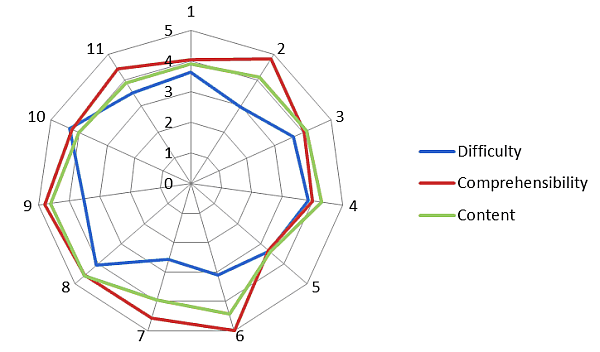
Figure 8: Rating overview of the e-flashcards of the 11 course members (arranged in descending order of final examination marks, 1 = best)
Figure 9 depicts the net diagram of the average rating of the 13 course members, who participate in the review session. Each course member rated between 18 and 34 e-flashcards. The net diagram shows that the average rating from some participants differs within the three categories difficulty, comprehensibility and content compared to other. It has to be explored in further courses if this effect depends on the pedagogical setting, in which the participants were asked to do the reviews.
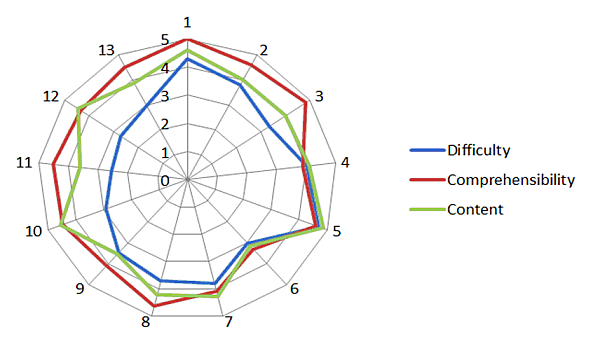
Figure 9: Average rating from each course member
Based on the principle of learning with flashcards [BM95] active and self-directed learning is supported by the mobile application. Due to the described feedback mechanisms, large groups of learners can give each other feedback to the self-generated e-flashcards and obtain individual feedback from tutors or lecturers.
Essential for the acceptance and use of e-learning cards by students is a sufficient number of correct high-quality e-flashcards in the e-flashcard pool. As part of the pilot phase and follow up courses in the following semester, the questions will be evaluated:
-
How are e-flashcards used in university teaching?
-
Do learners accept e-flashcards?
-
Which impacts have the use of e-flashcards on the learning outcome?
-
To what extent are the provided assessment and feedback mechanisms sufficient to generate logically correct and comprehensive e-flashcards?
-
Which impacts have reviews on the quality of other students’ e-flashcards?
-
How much effort is required for the quality filtering process?
A further analysis of the use of assessment and feedback functionality is suitable to obtain insights regarding open question formulated by [SS10], to what extent qualitative feedback and positive feedback from other students have a positive effect on the learning outcome.
Besides the individual repetition, e-flashcards can be used in the test mode to identify additional learning needs. Further customization options of the mobile application regarding time and self-management can support learners in the examination preparation phase. Through a combination with the calendar function, a time-controlled repetition of e-flashcards is realized. A combination of e-flashcards with other learning resources is also possible.
Further integration of a more individualized reward system is possible by combining the learning functionality with other functions of mobile devices, for example with mobile games and a text-to-speech functionality to use the mobile application during car trips.
The used concept of conversion and reuse of learning content modules in e-flashcard can be extended to other SCORM learning modules, for example test items and glossaries. In this case, the conversion program used to import the test questions from the QTI standard [IMS13] has to be modified. Huge texts, with inherently complex relationships, cannot be mapped directly to micro-learning modules such as e-flashcards. Consequently, the present approach is mainly used to support learning of facts, while the independent creation of e-flashcards makes higher demands on the learners (see for example [BM93]).
An extension of the used conversion program to more interactive elements (e.g., graphical or audio elements) from the QTI standard will be investigated in the future to achieve even higher levels of learning objectives through e-flashcards.
Thanks to the students Robert Zimmer and Williams Seugwou for the implementation of the described software.
[An12]: Android Operating System, http://www.android.com/ (last check 2013-05-01)
[BM93]: Browder, B. M.; Maura, L. R., Guidelines for flash card instruction. In: Journal of Behavioral Education, Vol. 3, 1993, pp. 235-245.
[Ca05]: Campbell, M. A. The impact of the mobile phone on young people's social life. In: Social Change in the 21st Century Conference, 28 October 2005, QUT Carseldine, Brisbane.
[Ch03]: Chai, L., To Have or Have Not: An Examination of Feedback, Learner Control and Knowledge Type on Online Learning. In: Proceedings of the 36th Hawaii International Conference on System Sciences, Hawaii, USA, 2003.
[CC08]: Chen, C.-M.; Chung, C.-J., Personalized mobile English vocabulary learning system based on item response theory and learning memory cycle. In: Computers & Education. Vol. 51, 2008, pp. 624-645.
[CK08]: Cress, U.; Kimmerle, J., A systematic and cognitive view on collaborative knowledge building with wikis. In: International Journal of Computer Supported Collaborative Learning, Vol. 3, 2008, pp. 82-100.
[EHM07]: Ebner, M.; Holzinger, A.; Maurer, H., Web 2.0-Technology: Future Interfaces for Technology Enhanced Learning? In: Stephanidis, C. (Ed.): Universal Access in HCI, Part III, HCII 2007, Heidelberg: Springer. LNCS 4556, 2007, pp. 559–568.
[Fed12]: Federal Statistical Office (Destatis), Number of students in Germany at record high. Press release 423 / 2012-12-05. Available online: https://www.destatis.de/EN/PressServices/Press/pr/2012/12/PE12_423_213.html (last check 2013-05-01).
[Hu05]: Hug, T., Micro Learning and Narration. Exploring possibilities of utilization of narrations and storytelling for the designing of "micro units" and didactical micro-learning arrangements. In: Online proceedings of the International Conference "Media in Transition 4: The Work of Stories", Cambridge (MA), USA, May 6-8, 2005. Available online: http://web.mit.edu/comm-forum/mit4/papers/hug.pdf (last check 2013-05-01)
[IL13]: Lernplattform ILIAS, Dokumentation der ILIAS open source e-Learning e.V., https://www.ilias.de/docu/ (last check: 2013-05-01)
[IMS13]: IMS Global Learning Consortium, IMS Question & Test Interoperability Specification, 2013. http://www.imsglobal.org/question/ (last check 2013-05-01)
[JIM11]. JIM 2011 – Jugend, Information, (Multi-)Media, Basisstudie zum Medienumgang 12- bis 19-Jähriger in Deutschland. http://www.mpfs.de/fileadmin/JIM-pdf11/JIM2011.pdf (last check 2013-05-01)
[Ko96]: Koschmann, T. (ed.), CSCL,Theory and Practice. Lawrence Erlbaum Associates, New Jersey, 1996.
[Mu06]: Mumford, E., The story of socio-technical design: reflection in its successes, failures and potential. In: Information Systems Journal, Vol. 16, 2006, pp. 317 – 342. Available online: http://images2.wikia.nocookie.net/__cb20110105132254/sociotechinfosec/images/7/74/Mumford_2006.pdf (last check 2013-05-01)
[Sq12]: SQLite Datenbank, Herstellerseite, http://www.sqlite.org/ (last check 2013-05-01)
[SH12]: Stahl, G.; Hesse, F. (Eds.), International journal of computer-supported collaborative learning. New York, NY: Springer. Vol. 7, 2012, 4 quarterly issues, 600 pages. Available online: http://ijcscl.org/?go=contents (last check 2013-05-01)
[SS10]: Schroeder, U.; Stalljohann, P., A Portal-Based Gradebook. In: Proceedings of the 10th IEEE International Conference on Advanced Learning Technologies. ICALT 2010, pp. 58-60.